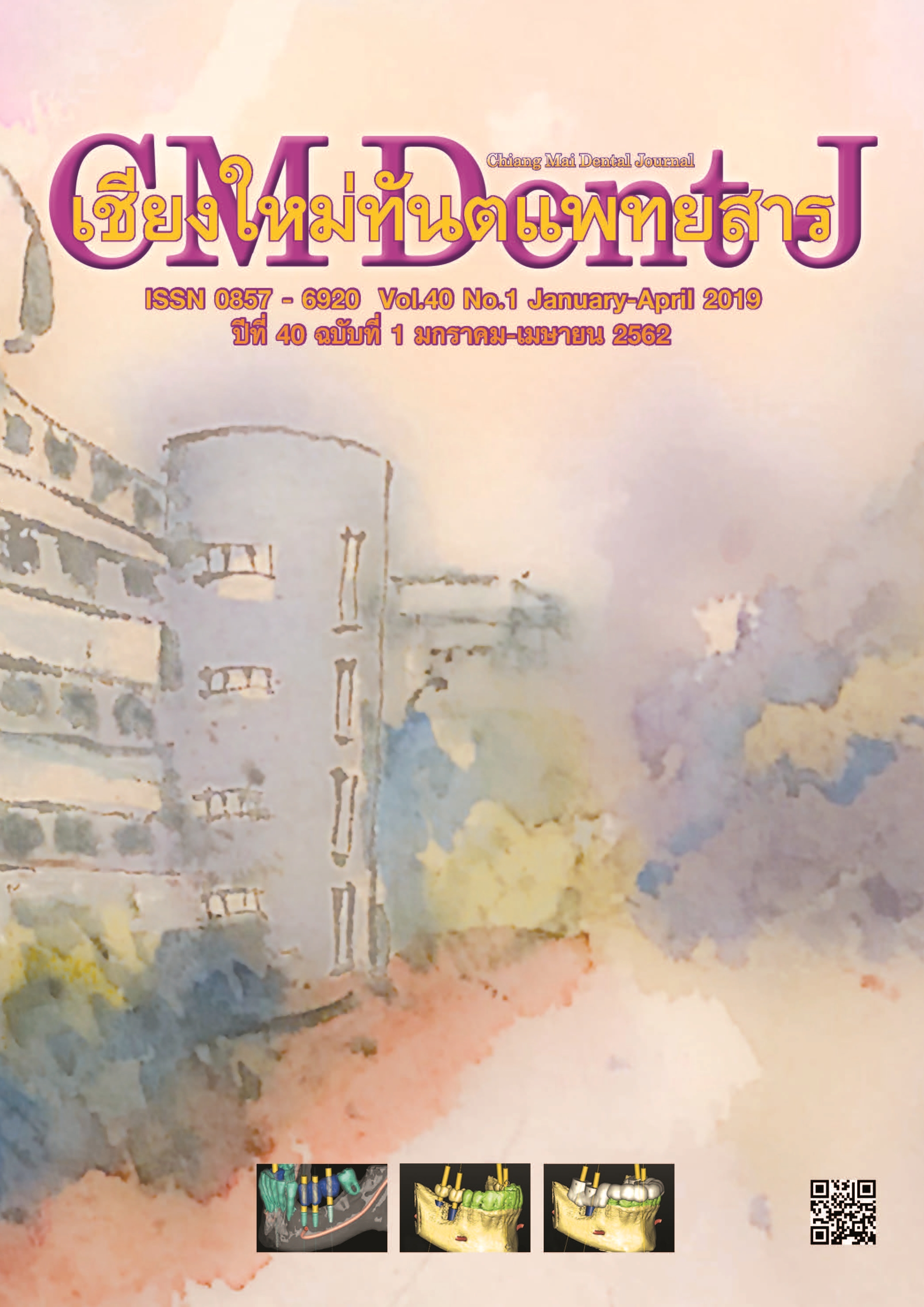Comparison of Maxillary Root Surface Areas in Thai Patients with Class I and Class II Skeletal Patterns Using Cone-beam Computed Tomography
Main Article Content
Abstract
Purpose: To compare root surface areas of maxillary permanent teeth in Thai patients with Class I and Class II skeletal patterns using conebeam computed tomography.
Materials and Methods: Pretreatment conebeam computed tomography images of 30 Thai orthodontic patients with Class I and Class II skeletal patterns were selected. Maxillary teeth from central incisor to second molar on both sides were chosen for investigation with 3-D dental crown and root construction. The cemento-enamel junction was identified and labeled; the area apical to the cemento-enamel junction was measured as the root surface area. Descriptive statistical analyses were performed.
Results: Mean root surface areas of maxillary permanent teeth from central incisor to second molar in patients with Class I skeletal pattern were 208.51, 193.87, 275.54, 258.70, 233.35, 447.41 and 386.26 mm2, respectively, and 203.55, 191.16, 262.44, 236.47, 227.91, 408.38 and 351.70 mm2, respectively in those with Class II skeletal pattern. Root surface areas of first premolar, first molars and second molars in patients with Class II skeletal pattern were significantly smaller than those with Class I skeletal pattern.
Conclusions: Root surface areas of maxillary first premolars, first molars and second molars in patients with Class II skeletal pattern were smaller than those with Class I skeletal pattern.
Article Details
References
Crabb JJ, Wilson HJ. A method of measuring root areas of extracted teeth. J Dent 1974; 2: 171-174.
Araújo SCCS, Vieira MM, Gasparotto CA, Bommarito S. Bite force analysis in different types of angle malocclusions. Revista CEFAC 2014; 16: 1567-1578. https://dx.doi.org/10.1590/1982-021620145113
Khumsarn N, Patanaporn V, Janhom A, Jotikasthira D. Comparison of Interradicular Distances and Cortical Bone Thickness in Thai Patients with Class I and Class II Skeletal Patterns Using Cone-Beam Computed Tomography. Imaging Sci Dent 2016; 46: 117-125.
Chaimanee P, Suzuki B, Suzuki EY. “Safe zones” for minis- crew implant placement in different dentoskeletal patterns. Angle Orthod 2011; 81: 397-403.
Boyd JD, Sims RW Jr, Osgood DR, Blum AS. Photographic versus autoradiographic portrayal of dental structure. Int J Appl Radiat Isot 1958; 3: 8-12.
Tylman SD, Tylman SG. Theory and practice of crown and bridge prosthodontics. 4th ed. St. Louis C. V: Mosby; 1960: 161-162
Jepsen A. Root surface measurement and a method for x-ray determination of root surface area. Acta Odontol Scand 1963; 21: 35-46.
Nicholls JI, Daly CH, Kydd WL. Root surface measurement using a digital computer. J Dent Res 1974; 53: 1338-1341.
Hujoel PP. A meta-analysis of normal ranges for root surface areas of the permanent dentition. J Clin Periodontol 1994; 21: 225-229.
Mowry JK, Ching MG, Orjansen MD, Cobb CM, Friesen LR, MacNeill SR, et al. Root surface area of the mandibular cuspid and bicuspids. J Periodontol 2002; 73: 1095-1100.
Pan JH, Chen SK, Lin CH, Leu LC, Chen CM, Jeng JY. Estimation of single-root surface area from true thickness data and from thickness derived from digital dental radiography. Dentomaxillofac Radiol 2004; 33: 312-317.
Yamamoto T, Kinoshita Y, Tsuneishi M, Takizawa H, Umemura O, Watanabe T. Estimation of the remaining periodontal ligament from attachment-level measurements. J Clin Periodontol 2006; 33: 221-225.
Li W, Chen F, Zhang F, Ding W, Ye Q, Shi J, et al. Volumetric measurement of root resorption following molar mini-screw implant intrusion using cone beam computed tomography. PLoS One 2013; 8: e60962.
Gu Y, Tang Y, Zhu Q, Feng X. Measurement of root surface area of permanent teeth with root variations in a Chinese population-A micro-CT analysis. Arch Oral Biol 2016; 63: 75-81.
Faul F, Erdfelder E, Lang AG, Buchner A. G*Power 3: A Flexible Statistical Power Analysis Program for the Social, Behavioral, and Biomedical Sciences. Beh Res Methods 2007; 39: 175-191.
Braun S, Bantleon HP, Hnat WP, Freudenthaler JW, Marcote MR, Johnson BE. A study of bite force, part 1: Relationship to various physical characteristics. Angle Orthod 1995; 65: 367-372.
Bakke M, Holm B, Jensen BL, Michler L, Moller E. Unilateral, isometric bite force in 8-68-year-old women and men related to occlusal factors. Scand J Dent Res 1990; 98: 149-158.
Andrews LF. The six keys to normal occlusion. Am J Orthod 1972; 62: 296-309.
Spencer MA. Tooth-root form and function in platyrrhine seed-eaters. Am J Phys Anthropol 2003; 122: 325-335.
Kupzcik K, Olejniczak AJ, Skinner MM, Hublin J. Molar crown and root size relationship in anthropoid primates. Front Oral Biol 2009; 13: 16-22.
Lucus L. Variation in dental morphology and bite force along the tooth row in anthropoids. Doctor of Philosophy, Arizona State University, August 2012; 243-260.
Enokida M, Kaneko S, Yanagishita M, Soma K. Influence of occlusal stimuli on the remodelling of alveolar bone in a rat hypofunction-recovery model. J Oral Biosci 2005; 47: 321-334.
Hayashi Y, Iida J, Warita H, Soma K. Effects of occlusal hypofunction on the microvasculature and endothelin expression in the periodontal ligaments of rat molars. Orthod Waves 2001; 60: 373-380.
Tanaka A, Iida J, Soma K. Effect of hypofunction on the microvasculature in the periodontal ligament of the rat molar. Orthod Waves 1998; 57: 180-188.
Karavade R, Kalia A, Nene S, Khandekar S, Patil V. Comparison of root-crown lengths and occlusal contacts in patients with class-III skeletal relationship, anterior open-bite and high mandibular plane angle. Int J Dent Med Spec 2015; 2: 7-13.
Uehara S, Maeda A, Tomonari H, Miyawaki S. Relationships between the root-crown ratio and the loss of occlusal contact and high mandibular plane angle in patients with open bite. Angle Orthod 2012; 83: 36-42.
Kim SY, Lim SH, Gang SN, Kim HJ. Crown and root lengths of incisors, canines, and premolars measured by cone-beam computed tomography in patients with malocclusions. Korean J Orthod 2013; 43: 271-278.
Tasanapanont J, Apisariyakul J, Wattanachai T, Sriwilas P, Midtbø M, Jotikasthira D. Comparison of 2 root surface area measurement methods: 3-dimensional laser scanning and cone-beam computed tomography. Imaging Sci Dent 2017; 47: 117-122.


